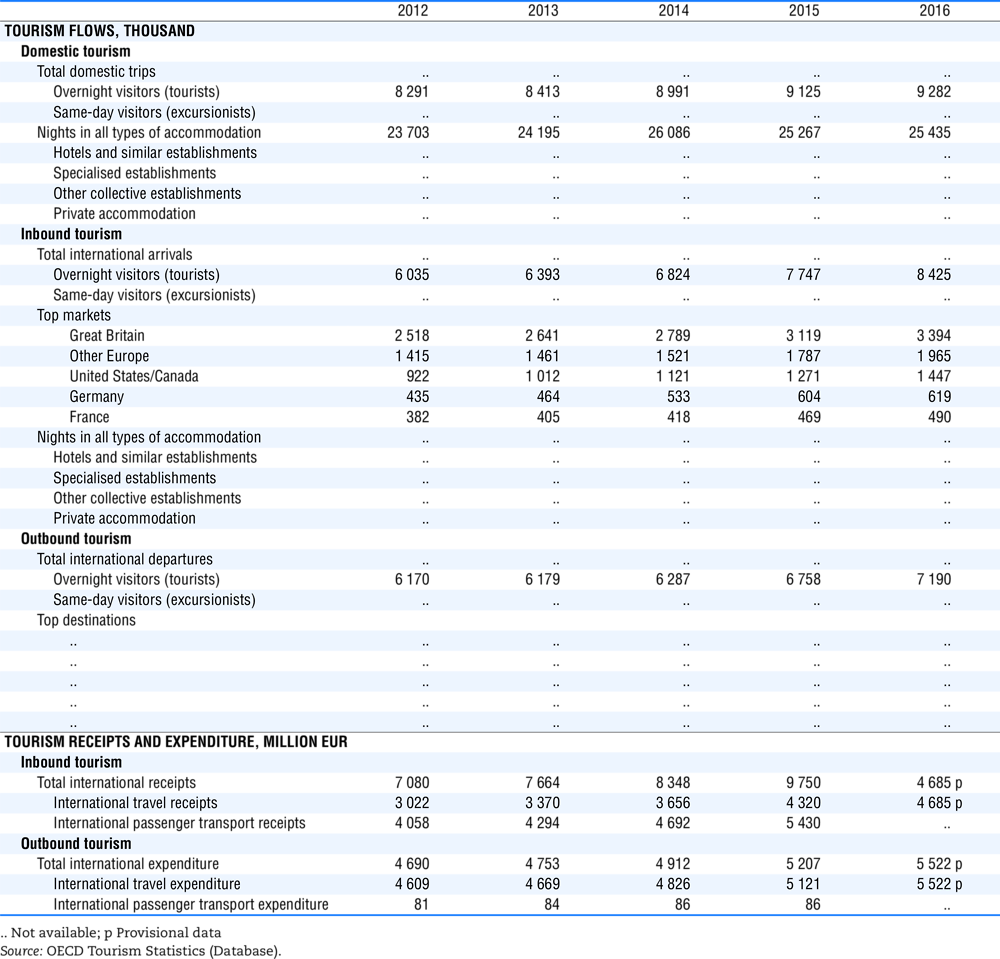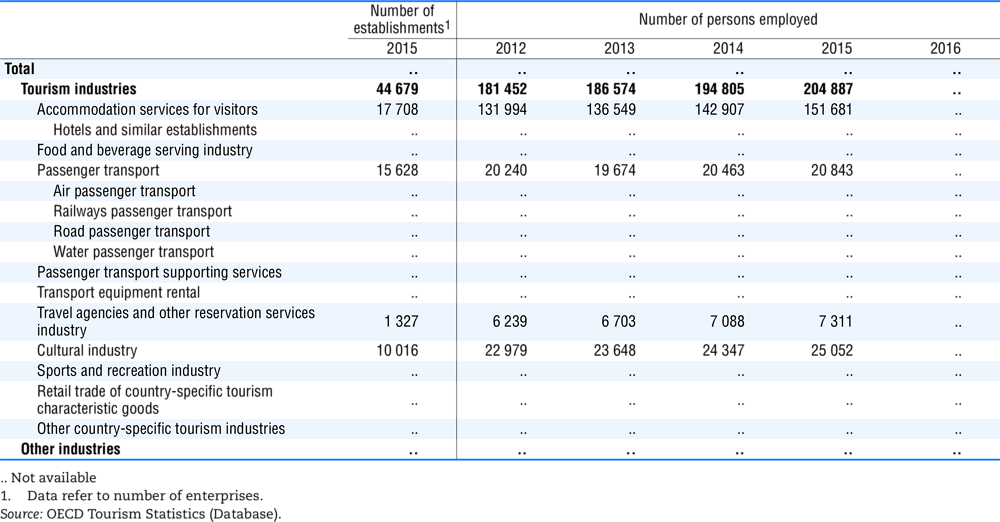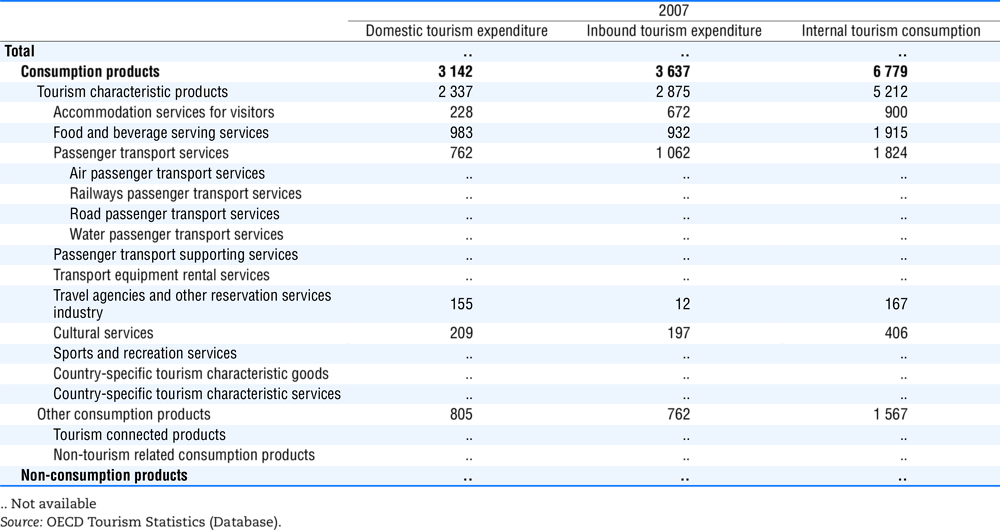Ireland
Tourism in the economy
Tourism is one of Ireland’s most important economic sectors and has played a significant role in the country’s economic renewal since 2011.
Since 2010, there has been a sustained increase in tourism activity, driven by increased numbers of overseas visitors. In 2016, the number of inbound arrivals increased by 10.9% over the previous year, bringing the total to 9.6 million. Growth in visitor numbers from North America was particularly strong, increasing by 19.4% to 1.8 million, while visitors from Great Britain, Ireland’s largest source market, increased by 10.6% to 3.9 million.
Total revenue from tourism in 2016 was EUR 6.7 billion (excluding Irish carrier fares of EUR 1.5 billion). Overseas visitors accounted for the greater part, increasing by 8.8% to EUR 4.6 billion, while domestic and cross-border visitor spend contributed EUR 2.1 billion, growing at a rate of 3.9%.
Overseas visitors and revenue grew again in the first half of 2017, up by 4.1% and 7.1% respectively.
Employment in the industry is estimated to have grown to 220 000 by the end of 2016.
Tourism governance and funding
The Tourism Division of the Department of Transport, Tourism and Sport sets national tourism policy, providing the strategic direction required to support the growth of a competitive and sustainable tourism industry. It does this through developing, implementing and influencing a range of policy actions and programmes of the Department, its agencies and other government Departments, in consultation with industry partners. Two tourism agencies operate under the aegis of the Department to administer policy:
-
Fáilte Ireland was established to support the tourism industry and sustain Ireland as a high-quality and competitive tourism destination. It provides a range of practical support to help tourism businesses better manage and market their products and services and develop experiences in line with new experience brands. Fáilte Ireland also promotes Ireland as a domestic holiday destination through its Discover Ireland marketing campaign and manages a nationwide network of tourist information centres.
-
Tourism Ireland Ltd is an all-island tourism marketing company with the overall objective of promoting increased tourism to the island of Ireland. It is accountable to the North South Ministerial Council, with funding provided by the Department for the Economy in Northern Ireland and by the Department of Transport, Tourism and Sport in Ireland.
Local Authorities have long recognised the important contribution of tourism to their local areas, and are active in many areas of its delivery, including organising and funding events, and developing public tourism infrastructure. Many work closely with Fáilte Ireland to develop these projects.
In its 2015 Tourism Policy Statement, the Government stated its commitment to a clear understanding of the responsibilities and expectations of Government, State agencies, Local Authorities, the tourism industry and other stakeholders in the development of the tourism industry, with an enhanced role for Local Authorities and recognition of the contribution of communities to tourism.

Source: OECD, adapted from the Department of Transport, Tourism and Sport, 2018.
The overall central budget allocated to tourism in 2017 is EUR 122 million, an increase of 0.9% on 2016. Of this, 58% goes to Fáilte Ireland, 41% to Tourism Ireland and 1% to the Department of Transport, Tourism and Sport.
Tourism policies and programmes
Notwithstanding strong performance in recent years, the tourism sector in Ireland faces a number of issues and challenges. Chief amongst these are:
-
The UK vote to leave the EU is a challenge for tourism in Ireland. The consequent depreciation in sterling has had a negative impact on the number of British visitors (down 6.7% in the year to September 2017). It will be important that Brexit negotiations, particularly in areas such as aviation, borders, the Common Travel Area with the UK, and joint visa arrangements, do not result in outcomes that are detrimental to the tourism sector in Ireland.
-
Access is critically important for Irish tourism given the country’s island status. Anything which reduces access, particularly air access, will lead to reduced numbers of overseas visitors.
-
Accommodation capacity, primarily in the main tourist centres at peak periods, has emerged as an issue with the strong sector performance of recent years. In particular, capacity in Dublin has been flagged as an issue. Evidence suggests that a number of hotel projects in the pipeline will help address this issue.
-
Many of the main visitor attractions suffer from capacity issues at peak periods. In 2016 Fáilte Ireland published a Tourism Investment Strategy 2016-2022, laying out funding streams and delivery mechanisms for a capital allocation of EUR 125.7 million to tourism product development.
A 2015 policy statement, People, Place and Policy – Growing Tourism to 2025, sets out the Government’s commitment to:
-
Place tourism as a key element of economic strategy, reflecting the highest standards of environmental and economic sustainability, and continuing to recognise and encourage its role in promoting peace and political co-operation on the island of Ireland.
-
Recognise the significance of Ireland’s people and place as assets in attracting an even greater number of overseas visitors in the future.
-
Ensure that Ireland is successfully promoted overseas, and that a balance of visitors from both mature and developing markets is achieved, visitors’ expectations are met, heritage assets are protected, and public investment in tourism is based on evidence of need.
-
Ensure that Ireland’s tourism industry has the capacity and capability to meet the changing needs of visitors.
In 2016, the newly-formed Government affirmed its commitment to work towards achieving the ambitious tourism policy goals set for 2025.
The Tourism Action Plan 2016-2018 sets out 23 specific actions required to help achieve these objectives, addressing a number of key issues including:
-
Training and skills in the tourism and hospitality sectors,
-
Visitor accommodation,
-
Overseas tourism marketing,
-
The visitor experience,
-
The contribution of sport to tourism,
-
Technology in tourism,
-
Planning for future growth.
The Plan allocates responsibility for each action to the Department, the tourism agencies and other stakeholders as appropriate. A Tourism Leadership Group meets approximately every six months to monitor progress. A new Action Plan for the period 2018-2020 will be drawn up in early 2018.
A key initiative in the last three years has been the establishment of geographic/thematic experience brands for the Wild Atlantic Way, Ireland’s Ancient East, and Dublin, which have been the focus of marketing and product development initiatives (Box 1.12). This distinctive “story-based” approach ensures that Ireland’s culture, history and heritage is brought to life by the stories found at its tourism offerings. These regional branding experiences have proved very successful and contributed to increased visitor numbers to the regions covered. They continue to gain traction internationally and are central to Ireland’s overseas marketing effort.



